#defeated by virtue of having character parallels
Explore tagged Tumblr posts
Text


“Dragonslayer” Moon Knight: Fist of Khonshu (Vol. 2/2024), #8.
Writer: Jed MacKay; Penciler and Inker: Devmalya Pramanik; Colorist: Rachelle Rosenberg; Letterer: Cory Petit
#Marvel#Marvel comics#Marvel 616#Moon Knight: Fist of Khonshu#Moon Knight: Fist of Khonshu vol. 2#Moon Knight: Fist of Khonshu 2024#Moon Knight comics#latest release#Moon Knight#Marc Spector#Ellen Carver#Ginnarr#defeated by virtue of having character parallels#comics are notorious for being fickle with which secondary characters they keep around#but with Mr. MacKay’s trackrecord with this series….I really hope he’ll follow through once more#and we’ll get to see this dynamic between Marc and Carver explored a bit more#it could be cool! Two former-SF human weapons soul-bound to bloodthirsty deities who are down for lethal measures#I would like to listen in on them casually shooting the breeze over a bottle of whiskey
7 notes
·
View notes
Text
Character Flaws vs Writing Flaws:
While catching up on some of the stuff people have commented/sent to me, I noticed someone mention how Katsuki being a bully is a flaw of his and that not every character needs to be a good person.
First of all, when did I ever say that a character has to be morally correct to be a good character? Some of my favorite characters are villains who’ve done worse things than Katsuki.
So what’s the difference between them and Katsuki?
Well, the villains have a reason for existing. Joker is meant to serve as a parallel to Batman, challenging his morals while also showing what an unhinged Batman could look like.
On a much lesser scale, despite his extremely limited screen time, Moonfish’s bloodlust, lack of sanity, and cannibalism serve two purposes in MHA: to showcase Fumikage’s power and to give the readers an example of what the heroes of this world have to deal with.
Katsuki’s flaws are meant to show the flaws of a world that values raw power over morals, but he fails at this. The reason why? His flaws are never allowed to be flaws.
Katsuki’s aggressive and hostile nature should have him struggling to make friends, yet he has the two pillars of 1-A, that being Ejiro and Denkias described by Hori, immediately befriend him with no issues. His inability to empathize with others should have people wanting to steer away from him, but his instead 1-A loves him, Eri loves him despite being the last person who would, and anyone who doesn’t love him is seen as being in the wrong.
Katsuki is meant to be a big fish in a little pond, someone whose ego isn’t challenged until a certain point, and the Battle Trials were meant to show this. While yes, Katsuki has a mini-breakdown over the fact that he’s no longer in a class of people with weaker quirks, he has no issue claiming a spot as a Top Dog and he still continues to demean the people around him.
Katsuki’s aggressiveness is meant to be both a flaw and an asset. His aggressive nature is what motivates him to defeat the villain, but it’s supposed to cause him to have a one track mind when it comes to hero work. Rescue, teamwork, all of that is ignored by him to fight the big bad. His ego caused everyone to have a tougher time during the USJ, but is that ever touched upon? Nope. It’s just ignored. When Katsuki saved Kyouka, there was no buildup to it. It just happens. We never see him struggle with teamwork because everyone else follows him like a lost puppy.
Meanwhile, Izuku is meant to be Katsuki’s parallel in this department. He’s meant to showcase why too much selflessness isn’t good while also showing that a hero is more than just their raw power. Problem is, Izuku gets completely shat on no matter what he does. He goes after a villain to protect U.A? Gets criticized. Does his best to work with Katsuki? Gets blamed despite it solely being an issue on Katsuki’s end. Does everything perfectly? Nope, still not enough. Compared to Izuku, who always seems to be in the wrong, Katsuki’s placed as this paragon of heroic virtues despite the fact both characters are supposed to be two halves of a whole. They’re supposed to learn from one another. Problem is, Katsuki’s flaws are always ignored while Izuku’s positive traits are demeaned.
Finally, Katsuki being a bully is supposed to serve as a starting point for his character. He’s meant to grow and develop as a human being. Again, he doesn’t, or at least he doesn’t do so in an organic way. He never suffers consequences for his behavior, he’s constantly propped up and coddled instead of criticized, and he’s given some heroic moments despite there being no buildup to them. In the span of a month he goes from nearly killing Izuku to risking his life for him. Where the hell did that come from? Honestly, I wouldn’t care if Katsuki being a bully is his sole purpose for existing, but he’s meant to be more than that. This is supposed to be a well developed and fully fleshed out character who grows from his selfishness and is meant to show that anyone can be a hero, no matter their starting point. But when the development is crap and he hardly changes outside of some OOC moments, then his flaws cease to be flaws that he’s meant to overcome. Instead MHA treats it as him being quirky and misunderstood.
In conclusion, you just can’t present something as a character flaw and expect it to serve as an excuse as to why a character exhibits said flaw. You have to think of the following: what purpose does this flaw serve? Is it meant to be used to teach a lesson? Does it set something in motion, whether it be the development of this character, another character, or does the flaw cause the character’s downfall? The only thing Katsuki’s flaws does right is that they set up Izuku’s story, which again would be fine if that’s Katsuki’s purpose, but it’s not. Him being a bully isn’t something that he overcomes in a natural way. His redemption story is the equivalent of filling things out of a checklist without being fleshed out. Every time he screws up, it’s never treated as a screw-up. Oh he failed the hero license exam? Well so did Shoto so he’s not unique there, and the proctors still suck his dick even while he’s “failing”. Him being the reason for 13’s injuries? Never brought up.
Katsuki’s flaws don’t piss me off because they are flaws, but because the writing of his character IS so deeply flawed despite being a centralized character in the story.
Oh, and as always, someone can dislike a character for whatever reason they might have. If people don’t like Katsuki because he’s a bully, then they have every right to. What I wrote is a response as to why I think Katsuki’s a shit character and how it’s not because of his flaws themselves, but how Hori goes about writing these flaws.
#anti katsuki bakugou#anti bakugo katsuki#anti bakugo#anti bakugou#mha critical#anti bakugou katsuki#bnha critical
385 notes
·
View notes
Text
galadriel's whole arc really can be summarized by nietzsche's quote:
"whoever fights monsters should see to it that in the process they do not become a monster. and if you gaze long enough into an abyss, the abyss will gaze back into you."
her whole rant to adar about exterminating all of his children while keeping him alive to witness it was actually so deranged, i can't believe that they let her be so flawed of a character.
and those aren't "accidental" traits that the show isn't aware are "vices" rather than "virtues", as adar basically called her morgoth's successor to her face after her speech!
she even rejected the heaven bc she couldn't let go of her desire to exact her revenge on sauron.
it makes one think, no wonder that the elves could no longer distinguish her from the evil she fought to defeat (galadriel/sauron's pre-raft storylines parallel too perfectly).
as she did inadvertently keep alive the very evil she sought to defeat, inside her very heart and also quite literally.
and that darkness she pursued so relentlessly, the darkness that is personified by sauron, looked back at her and from the first moment sauron lay his gaze on her, something like a revelation hit him, and the obsessive pursuit became mutual.
indeed, those were the seeds she'd planted and sauron would go on to grope for her mind forever bc she let him in. she let sauron in long before he won her trust as halbrand.
and she might have kept her own darkness at bay later on and closed the doors to it, not consumed by revenge anymore, but she never stopped fighting or thirsting for power, and with trop context all of this is intrinsically connected to sauron. even taking nenya to valinor is given a new layer of context, she holds onto the symbol of her fight and of sauron, taking it with her to valinor (remember how in 1.01 she asked elrond whether he would have her take the fight in her heart to the heaven? oh, maybe she did after all...)
i just love that the lady of the light actually has so much darkness of her own. she is simply so nuanced and complex, and not confined to the limits of what a female protagonist should be like. it's not just her darkness, her pride either. it's not just flaws she is allowed, she is allowed genuine weaknesses. she is so abrasive and reckless that sauron had to make sure she didn't get them drowned in the numenorean sea, lmao. and even her strongest virtue isn't a typical "feminine" virtue, it isn't common sense or nurture, it is willpower.
#poetic cinema#the rings of power#sauron x galadriel#haladriel#saurondriel#trop#rop#galadriel x halbrand#galadriel#sauron
154 notes
·
View notes
Text
The Parallel Romantic Relationships of Becky Sharp, Scarlett O' Hara and Cersei Lannister
Through my readings of Vanity Fair, Gone with the Wind, and A Song of Ice and Fire, I’ve noticed striking similarities between the relationships of Becky/Rawdon, Scarlett/Rhett, and Cersei/Jaime:
Femme Fatales
In each pairing, the women embody the archetype of the femme fatale, wielding their charm, beauty, and performative femininity to manipulate their primary love interests — though Scarlett is notably less successful in bending Rhett to her will — as well as other secondary male characters. Becky seduces and maneuvers around Jos Sedley, the members of the Pitt family, and Lord Steyne. Scarlett exerts influence over her first two husbands, Charles Hamilton and Frank Kennedy. Cersei exploits Lancel Lannister and Osney Kettleblack.
Unwavering Devotion
In each pairing, the men are deeply enamored. Rawdon worships Becky in the early years of their marriage, regretting his degenerate past as he cannot provide her with the opulent life she desires. Rhett devotes much of his time on the page to physically and financially protecting Scarlett while also offering her emotional solace. Jaime sacrifices his inheritance to stay close to Cersei, setting aside his own desires to maintain their secretive, co-dependent relationship.
"Redeemable" Men
In each pairing, the men have reputations that precede them — Rawdon for his debts and gambling, Rhett for his scandals and for taking advantage of the Civil War through the blockade, and Jaime for murdering Aerys. Initially, they seem morally on par with the women — Rawdon joins Becky in extorting money, Rhett himself describes Scarlett as his selfish equal, and Jaime is presented as one of the first book's main antagonists, alongside Cersei. However, as the story unfolds, it becomes clear that the men adhere to a code of honor that the women lack — Rawdon repays Miss Briggs' loan despite Becky’s intentions to avoid it; Rhett fights for the Confederacy, knowing defeat is imminent; and Jaime saves Brienne during their journey back to King’s Landing.
Parenting Differences
In each pairing, the men also prove themselves to be, if not better (in the cases of Rawdon and Rhett), at least more empathetic parental figures. Becky harbors outright disdain for her son, and Scarlett neglects the children from her first two marriages, while Rawdon and Rhett are proud, affectionate, and invested fathers. Cersei, though more loving, overindulges Joffrey and takes her frustrations out on Tommen — which is contrasted (even if only briefly) with Jaime's more balanced approach.
"Good Woman" Foils
In each pairing, the women are juxtaposed with a female character whose genuine kindness and virtue — qualities that Becky, Scarlett, and Cersei can only feign — earn the respect and admiration of the male counterparts. For Becky, this woman is Jane Crawley. For Scarlett, it's Melanie Wilkes. For Cersei, it's Brienne of Tarth.
Forsaking Partners
In each pairing, in their relentless pursuit of power, security, or social ascension, the women start casting aside their male counterparts in favor of more superficial or opportunistic company. Becky ingratiates herself with members of the British elite. Scarlett mingles with the new-money Republicans who have risen to prominence in Atlanta. Cersei places her trust in figures such as Qyburn and Taena Merryweather.
Revelations of Infidelity
In each pairing, one of the decisive factors leading to the respective separations is the discovery of the women’s infidelities, validating their male counterparts' simmering jealousies. Rawdon catches Becky schmoozing with Lord Steyne, though the novel refrains from confirming whether their relationship was sexual. Scarlett’s friendly embrace with Ashley is misinterpreted, and word of it eventually reaches Rhett. Cersei’s affairs are exposed to Jaime by Tyrion and later verified by Lancel.
Violent Reactions
In each pairing, the men react to the women’s infidelities with violent anger. Rawdon strikes Lord Steyne and trashes Becky’s belongings. Rhett intimidates Scarlett with his drunken rages. Jaime, distanced from Cersei once his suspicions are proven true, fantasizes about physically harming her and her lovers.
Prolonged Relationships
In each pairing, the relationships endure for an extended period, intensifying the men’s eventual bitterness. Becky and Rawdon’s marriage lasts for over a decade. Rhett’s pursuit of Scarlett spans six years, with their marriage continuing for another six. Jaime and Cersei’s sexual relationship begins in childhood and persists into their early thirties.
Desperate Pleas
In each pairing, the women eventually make a desperate plea to their male counterparts. Becky enlists Rawdon's brother to persuade him of her innocence. Scarlett confesses her love to Rhett and invokes the intense feelings he once had for her. Cersei sends Jaime a letter asking him to rescue her from the Faith.
Dismissive Rejections
In each pairing, the men are too emotionally drained to continue the relationship and reject the women in rather careless ways. Rawdon refuses to speak to Becky while claiming the position she secured for him through her flirtations. Rhett shuts Scarlett down with the famous line, “Frankly, my dear, I don’t give a damn.” Jaime coldly dismisses Cersei’s plea with, “Put this in the fire.”
It was only recently, though, that I learned Margaret Mitchell was accused of drawing inspiration from Becky for Scarlett when Gone with the Wind was released. Mitchell denied this, claiming she hadn’t read Vanity Fair at the time, despite it's author even being referenced in her book through a conversation between Rhett and Melanie. And, if you're familiar with George's work, you’ve likely heard him repeatedly ask, "How many children did Scarlett O'Hara have?" when discussing the differences between a novel and it's adaptation. In fact, George has mentioned Gone with the Wind in several interviews, even acknowledging that he read the sequel by Mitchell’s estate, which he strongly disliked. This makes one wonder whether the evolution from Becky to Scarlett, and from Scarlett to Cersei, and consequently their romantic narratives, is truly coincidental.
#becky sharp#rebecca sharp#rawdon crawley#scarlett o'hara#rhett butler#cersei lannister#jaime lannister#vanity fair#gone with the wind#a song of ice and fire#asoiaf#literary parallels#meta#valyrianscrolls
26 notes
·
View notes
Text
A couple observations I neglected to mention in my Scream video
Looking back over my initial notes, I noticed a couple of things that didn't make it into the final script, but I still think are pretty interesting and relevant to sex/gender/power as depicted in Scream.
Juxtaposition of Stu holding Billy from behind and Billy holding Sid from behind in the kitchen scene. This sets up a parallel between the two pairs as romantic couples. There might also be something to be said about how Stu holds Billy out of an affectionate desire for closeness, while Billy holds Sid primarily to restrain her (though he does stroke her hair in a perversion of when he offered her comfort in the master bedroom upstairs).
In the Watsonian Explanation section, I interpreted that "Billy & Stu exhibit the queer tendency to identify with villains to such an extent that they have adopted their behavior themselves- this is the only way they know to express themselves fully, they can only be queer when they are being villainous." However, I left out that this interpretation fits with the broader meta-commentary of the film, how "movies don't create psychos; movies make psychos more creative." This line could be retooled to say, 'movie villains don't turn your kids gay, movie villains give gay kids an avenue to express themselves,' or something along those lines.
The parallels between Billy and Norman Bates, two 'pansy-assed mama's boys.' As Norman says in Psycho, “a boy’s best friend is his mother." For both characters, their mother is the most important figure in their life, the source of their motivation to kill, and the apparent source of their issues (“maternal abandonment causes serious deviant behavior”). Additionally, in his villain reveal Billy directly quotes Norman ("we all go a little mad sometimes,") though he attributes the quote to Anthony Perkins, his actor, and a famously gay man. Also, Sidney's anxiety about turning out just like, or in essence ‘becoming,’ her mother might align her with Norman as well.
In the audio commentary at 1:12:10, Kevin Williamson remarks, "[Sidney's] going to have sex, and now the audience is left to question: will she or won’t she live?" Notice how the question is framed, 'will she or won't she live,' not 'does she or doesn't she deserve to live.'
At page 39 of her essay, Brooke Shapiro writes, "Mulvey further explains that the female protagonist falls in love with the male protagonist and becomes his property throughout the narrative." In Scream, while she does submit to sex with Billy, Sid falls out of love with him and asserts her independence from him at the end of the movie by literally killing him.
Regarding the heroine's journey beginning with the feminine and embracing the masculine, when we are first introduced to Sidney, she is wearing a very girly nightgown, and at the end of the film she is wearing pants.
At page 59 of Visual Pleasure in Narrative Cinema, Mulvey writes that "there are circumstances in which looking itself is a source of pleasure, just as, in the reverse formation, there is pleasure in being looked at." One interpretation of this is perhaps the joy of not simply being looked at, but being seen- or, being seen for who you truly are. This is evident in Billy & Stu's joy after they let the masks drop and reveal themselves as the killers.
Visual Pleasure at page 64: "voyeurism. . . has associations with sadism. . . This sadistic side fits well with narrative. Sadism demands a story, depends on making something happen, forcing a change in another person, a battle of will and strength, victory/defeat, all occurring in a linear time with a beginning and an end.” I think this analysis pretty perfectly describes Billy & Stu.
On page 754-755 of Freeland's essay, she writes, "slashers also reinforce cultural messages about the virtues of masculinity by presenting a villain who is defectively masculine- often someone pudgy, awkward, shy, or seemingly impotent- and a heroine (the ‘Final Girl’) who is more masculine than feminine." I wouldn’t describe Billy or Stu as defectively masculine in the ways outlined here. Queer coded? Sure. But not particularly effeminate. I do also think that Sid is fairly androgynous in behavior and often dress, but it is very important to the narrative and themes of the story that she is a girl. Her struggles surrounding sex are deeply dependent on the cultural expectations for women.
If you missed it, you can watch my video on Scream here.
12 notes
·
View notes
Note
Heya Loon Star 👋
You mentioned watching “The Princess Bride” earlier. It’s a great movie! I’m wondering, do you have a favorite film? Or even a few?
Hope all is well, pal!

LOON: Hello to you too, friend! I haven’t seen the full extent of films that the Internet can give me, but I have an affection for The Last Unicorn (1982) and The Secret of Nimh (1982).
The latter was brought into the daycare by a little girl who’d wear a red jacket, and she would only go to sleep if we put it on before naptime. Gwen’s primary guardian said she only goes to sleep with the movie playing.

Of course, my favorite Fazbear Entertainment piece of media is the animated short film starring the FazRangers in Space (1987), wherein they meet a star princess and help her reignite her kingdom, which was shrouded in mysterious darkness when an evil warlock wreaked havoc upon her kingdom centuries ago, leaving Princess Bunnie to wander the darkness till FazRanger Chica’s courageous and compassionate nature would melt her from the shadowy grasps of fear and hopelessness, also tying together the healing of her kingdom with the healing of Princess Bunnie’s heart, and she learns to stand against the darkness that stole her kingdom from her with the combined power of friendship and maybe even love when FazRanger Chica grows even closer to her yet as she feels safest to open up to the most compassionate and caring person of the team, though FazRanger Bonnie cuts a close second by virtue of being so calming and patient, regardless the heart of the space kingdom is restored with Princess Bunnie’s defeat of the dark matter devouring the crystal palace’s control helm, which is actually belonging to the ginormous spaceship that the kingdom is built on, which has been masquerading as a mysterious and random moon this whole time, and then the FazRangers bid goodbye to the Princess and head back home with a brand new spaceship with high tech lunar technology combined with a Fazbear paintjob to make it look even cooler, and then they all go home but not without Princess Bunnie asking if FazRangers Chica, Freddy, and Bonnie want a souvenir from her kingdom because there’s no way she’d let her best friends leave without remembering their wonderful adventure to fight the forces of darkness and evil, and she gives them each a piece of her everlasting love to light their paths through the darkest struggles, so that they remember their love for one another even when having petty friendship squabbles that could turn into something so dramatic that it’d destroy kingdoms. The piece of her love is contained in the memory of her true name, Princess Stella. How incredible.
I have watched the movie many times. I am sorry, the summary is not so complete with every major plot point. I have included the best parts, mostly, because it’s very fazerrific. You should watch it. I have also written many articles about the nature of Princess Bunnie’s relationships with each of the FazRangers, and exactly how they parallel the stages of healing in her kingdom, moreover how the writers reduce Freddy Fazbear, star of the show, to a more stable and flat role that is better for young audiences to project onto but incidentally butcher his character. Freddy is very heroic but he also feels jealousy towards Princess Bunnie, which is guilty and shameful of him, and also not really something that animatronics are meant to truly feel except that he does which is very um interesting and provides a good role model for children to understand a potrayal of certain emotions, especially how to handle their jealousy or insecurity when a dear, old friend seems to favor someone else over you.
17 notes
·
View notes
Text
Alright, folks, I rewatched the Bo’re Life arc this week, and I have thoughts and a newfound appreciation for it (what? Me? Liking the Bo’re arc?It’s more likely than you’d think). As my mom used to say at the start of road trips or our semi-annual family viewing of The Sound of Music: buckle up, chitlins.
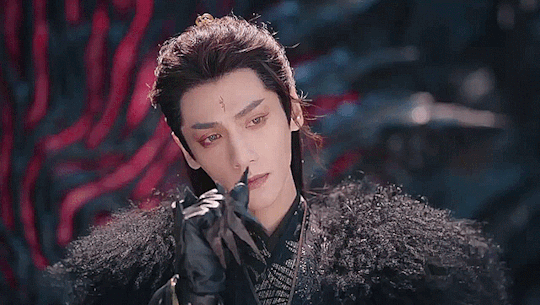
Okay, first off: this arc is a lot easier and more interesting to watch the second time around. I suspect that’s because I’m not chomping at the bit to just get back to Tantai Jin and Susu in the real world, since I already know what happens. This time, I can settle in and appreciate Bo’re Life without the urgency of “when is the actual story going to come back, fuck you writers”. It’s also very fun for me to draw parallels and find foreshadowing I didn’t notice before. And, having done so, I present the following thesis: the Bo’re Life arc strengthened the overall story both as a tragedy, and as a “happy” ending.
Addendum: I have a lot of thoughts about what constitutes a happy ending, and my thoughts on TTEOTM in this regard are complicated. Essentially, I would argue that the ending, while certainly sad, isn’t a “tragedy” in the narrative sense. While the individual happiness of the characters takes a real blow in the end, they do accomplish their ultimate goal. It’s a pyrrhic victory, but a victory nonetheless, and it’s implied that they will get a much happier ending as individuals sometime in the future. That doesn’t mean it was as satisfying as it could have been (it seems clear that TTJ will come back but I'm pissed we didn't get to see it), and I know a lot of viewers will totally disagree with my opinion. But I digress! Let’s get into Bo’re Life.
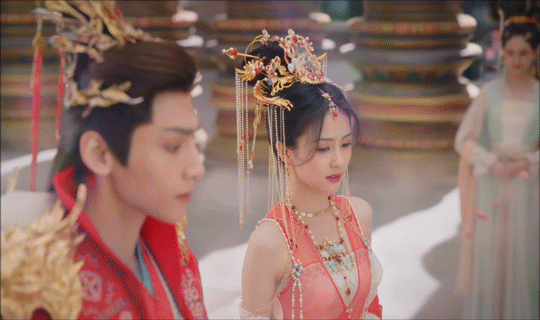
Bo’re Life threw a LOT of information at both protagonists, and the roles they played in it didn’t correspond neatly with their own destinies, which kind of baffled me the first time around. Ming Ye represented both what Tantai Jin could aspire to be, and the mistakes Susu needed to avoid in neutralizing him. Sang Jiu represented both Susu’s traumas and doomed loveline, and Tantai Jin’s fate if Susu failed as Ming Ye had.
The parallels between Bo’re life and real life perfectly underline the tragedy of the story: both protagonists are shown beforehand the choices they must not make, but because of who they are, they make them anyway.
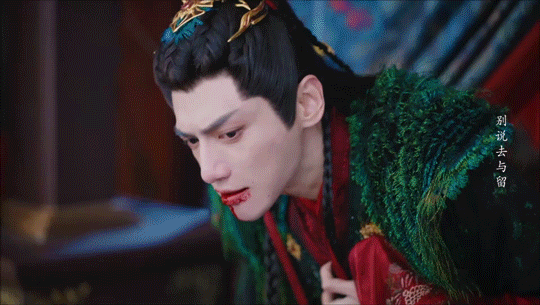
Susu was an idealistic and traumatized woman with a mission, so she was always going to fail like Ming Ye did by putting the greater good ahead of love and communication. Tantai Jin was a disempowered and naive man falling in love for the first time, so he was always going to be just like Sang Jiu and give his fragile heart too fully, then shatter under the weight of betrayal. Bo’re Life both foretold the tragedy, and failed to prevent it.
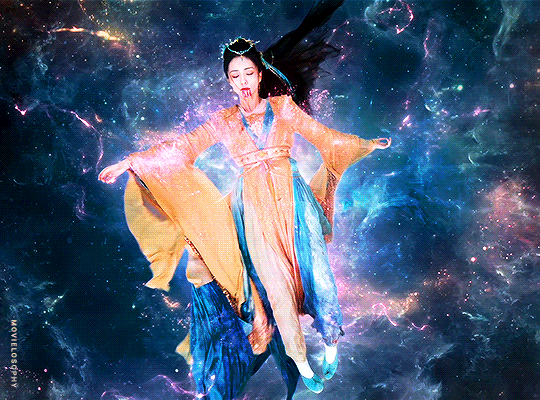
It could be argued that Tantai Jin and Susu played the wrong roles in Bo’re Life to avoid tragedy in the Jing arc, but they played the right roles to avoid it in the cultivator arc. In the mortal world, Susu needed Ming Ye’s experience of losing everything because he neglected his heart. And Tantai Jin needed Sang Jiu’s experience of subsuming herself in another person so recklessly that she lost her soul to it. Neither of them got that, and so they repeated the tragedy of 10,000 years ago: Susu by loving and then betraying Tantai Jin, and Tantai Jin by allowing his obsessive love to run unchecked.
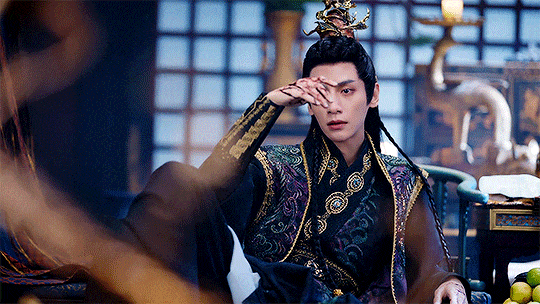
But as cultivators, 500 years later, they both ended up relying on the virtues of the roles they played in Bo’re Life. Susu channeled Sang Jiu’s optimistic love and staunch loyalty to repair her relationship with Tantai Jin and become someone he could genuinely rely on. And Tantai Jin needed Ming Ye’s sacrificial love and dedication to the greater good to understand and execute his subversion of destiny.
This time around, they were both where they needed to be, playing the roles fate assigned them… but drastically changing the lines. Susu became a goddess, just like her mother, the only being who could defeat the Devil Lord. And Tantai Jin became the Devil Lord, just as he was born to do. But there was no battle between them, no great war like 10,000 years ago. Just like during their dance at the Jing water festival, Tantai Jin played his part, then surrendered.
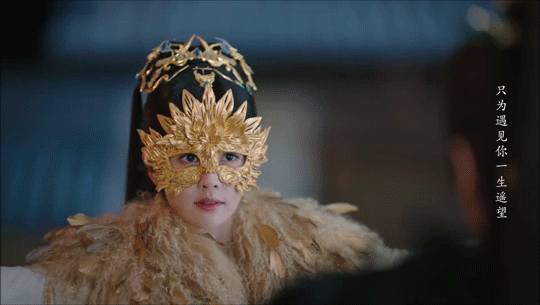
And, just as she removed his mask 500 years ago, Susu saw through his act to who he really was, who he’d always been.
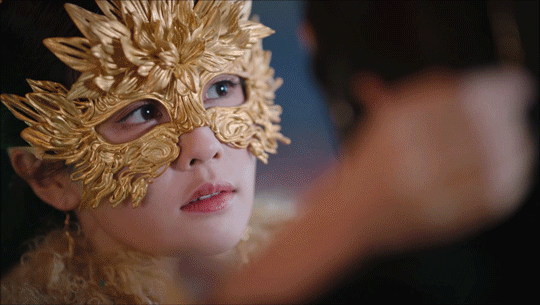
They redeemed the very mistakes they made at the end of their story in Jing: Susu, who couldn’t trust him and destroyed him as a result, finally gave him her trust, even as he wore the image of her greatest fears. And Tantai Jin, who was so desperate for her love that he killed her trying to keep her, finally let her go to save the world.
The Jing arc ended with both of them as the worst versions of themselves: Susu vengeful and traumatized, Tantai Jin obsessive and broken. As she died, Susu threw Tantai Jin’s destiny in his face, calling him the greatest curse and rejecting him in this life and the next. In his last days in Jing, Tantai Jin devolved into despair and denial, unable to cope with the grief and betrayal. They didn't learn the correct lessons in Bo're life, not this time around.
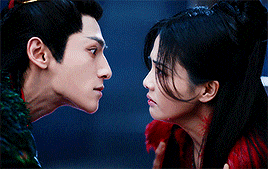
By contrast, the cultivator arc ended with both of them as the best versions of themselves: Susu capable of trust and forgiveness and elevated to godhood, Tantai Jin whole and loved and able to overturn his evil destiny. They learned, not just from their own mistakes, but from those of Ming Ye and Sang Jiu. And it helped them win.
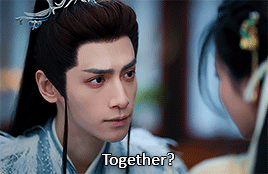
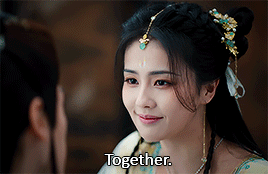
131 notes
·
View notes
Text
IWTV Musings - LDPDL & Nosferatu 2024 (Pt6b: Loustat & Thorlock)
I've been in my Louis = Ellen bag for the past few IWTV/Nos24 posts, since they're the main characters & main love interests of their vampire lovers. But I've been dying to sink my teeth (shut up) into the Louis = Thomas parallels of it all. And not even really cuz of Nos24.... But cuz of Nos79.

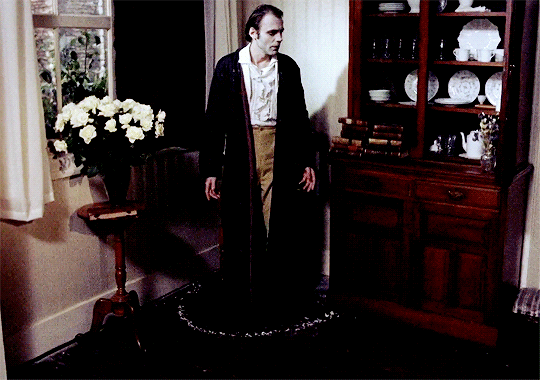
Fun fact: In Werner Herzog's 1979 Nosferatu, Jonathan Harker/Thomas Hutter is actually turned into a vampire by Dracula/Orlock.
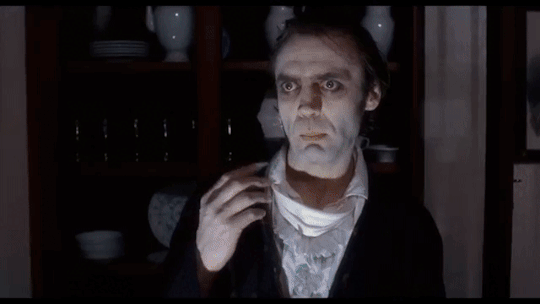
AMC's Interview with the Vampire is the first time in a major project that the physical bond between the vampire MALE antagonist and human MALE protagonist is played straight (LOL), and the vampire's lover/prey is actually turned into the vampire's lover/companion; rather than escaping the vampire's clutches alive & human (Jonathan/1922!Thomas)--let alone staying human but dying/sacrificing themselves to kill the vamp (Ellen); or losing their vampirism once Dracula's dead to become human again (1992!Mina).
But Herzog planted the seed for subverting/inverting the Dracula formula: For the female gothic protagonist, she dies, sacrificed & martyred with the Christian religious salvation arc as the power of innocence/virtue defeats the Devil/Dragon ("Dracul"). But the male gothic protagonist is run ragged, loses everything/everyone, and succumbs to the monster/Beast lurking inside him; perpetuating the vampire curse and joining the Damned, not the Saved.


The homoerotic undertones of Dracula/Orlock's dynamic with Jonathan/Thomas have long been established (x x); since everyone knows the vampire bite/exchange of bodily fluids = penetration/sex. But because of late 19th/early 20th century homophobia, bisexual subtext was all they could get away with back then. But real talk, Jonathan/Thomas should count as one of Dracula's Brides, too (even if he is sometimes/technically the "bait/surrogate" for the real love interest Mina/Ellen, a la Lucy).
Dracula & Jonathan
In Coppola's 1992 Bram Stoker's Dracula, Jonathan has the (in)famous orgy with Dracula's Brides; but Dracula swoops in, furious at them for taking what's his.

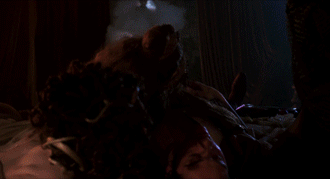

Then Dracula carries Jonathan to his bedroom & undresses him. 👀

And Jonathan is so discombobulated that it's like he's been roofied & date-raped in a black-out. 👀👀
The next time we see Jonathan, he's desperately making his escape from Dracula's castle, absolutely covered in bite marks. And if the Brides had been ordered to stay away from him, then that means Dracula's been FEASTING on Jonathan every night. Dracula lets Jonathan escape, but not without a final bit of petty spitefulness, using telekinesis to push Jonathan off the ledge and fall into the river. The trauma of everything Jonathan's gone through DOES physically transform him--not as vampirism, but as age, where his black hair has gone grey from the mental AND physical stress. He's in this liminal state b/t life & death, as he's gotten old prematurely cuz of his encounter with the supernatural--Dracula's still left a permanent mark & changed him.
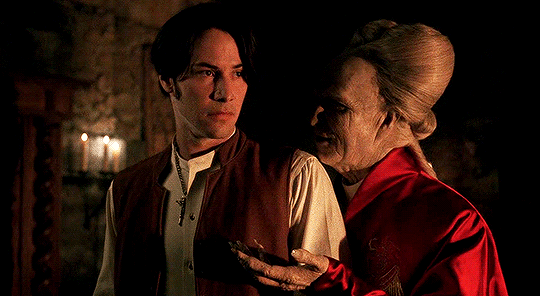
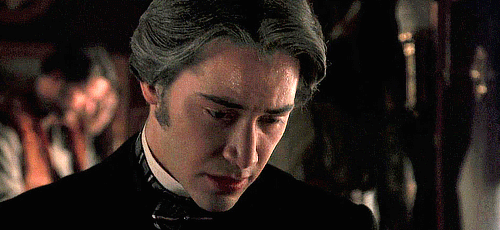
Orlock & Thomas
Robert Eggers' Nosferatu 2024 is WAY more in-your-face about Thorlock's sexual dynamic, where he explicitly swaps Thomas & Ellen in & out as Orlock feeds on him. Orlock gives him hallucinations of Thomas having sex with Ellen, as Orlock makes Ellen have dreams of her having sex with Orlock--when really it's Orlock feeding on Thomas... while butt naked & humping/thrusting against Thomas.

Not to mention, the scene with Thomas discovering Orlock's coffin is the ONLY time we see Orlock in full frontal nudity, the peen just on display--phallic imagery being something Eggers often insists on having in his homoerotic films (a la The Lighthouse). Orlock's not ERECT when he COMES Out of his coffin for Thomas, but the STIFFY'S a close call--

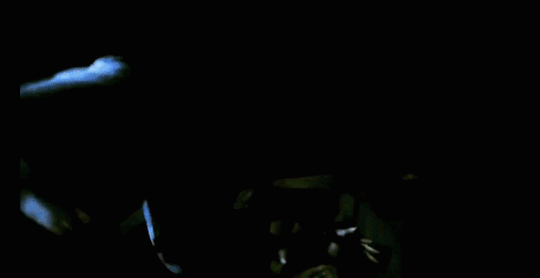
--alright I'll stop. 🍆🤦😅
24!Thomas doesn't become a vampire, and he doesn't go grey, but Thomas IS still physically affected/traumatized by Orlock--in his own desperate escape from Castle Orlock, Thomas (also bitten up, though this time we KNOW it was by Orlock) slips & falls into the river, and breaks his leg. For the rest of the movie, he's hobbling around all over the place, and it slows him down so that he can't even make it back to Ellen in time before the sun rises & she & Orlock die.
But the 1979 version takes things way more literally. 79!Jonathan/Thomas is stalked & seduced in a manner not unlike Lucy/Ellen's, as Dracula/Orlock is drawn to him just as strongly.

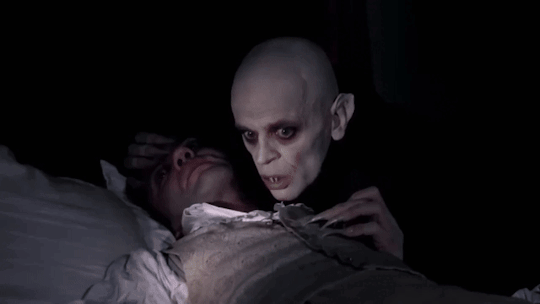
Lucy/Ellen is killed by Dracula/Orlock's bite, but Jonathan/Thomas survives--forever; becoming the next Nosferatu to carry on the vampiric legacy of death & destruction.

Casper, Kent, and Susan Linville. “Romantic Inversions in Herzog’s Nosferatu.” The German Quarterly 64, no. 1 (1991): 17–24.



IMO the connection b/t Louis DPDL and Jonathan/Thomas is most interesting in 1979 Nosferatu, cuz although Louis is THE Mina/Ellen (female-coded in everything but biological sex), he's also turned into a vampire like 79!Jonathan/Thomas, which no other version does.
So extra kudos to AMC's Rolin Jones for going the distance to take the homoerotic subtext and truly make it TEXT--not just wrt to Anne Rice's Vampire Chronicles universe, but the larger Dracula/Nosferatu universe she was inspired by. 👏🏳️🌈
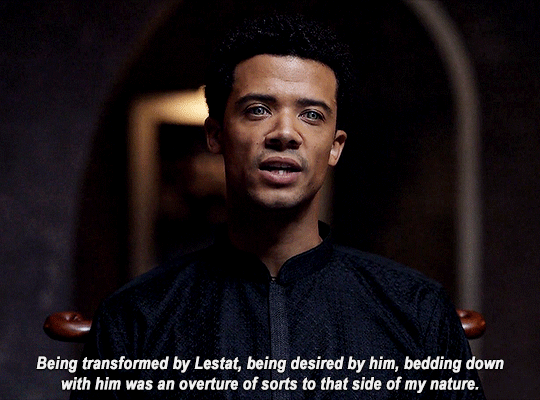
#interview with the vampire#nosferatu 2024#louis de pointe du lac#bram stoker's dracula#dracula#lgbt#lgbtqia+#iwtv tvc metas
9 notes
·
View notes
Text
you need to understand limbo is a sakura so in every way shape form seimei must in essence either be an emiyaface (unfailing hero who saves even the evil) or (more likely to me) a kireiface (obsessed with human evils beyond human virtues). nagiko who is implied to be ashiya doumans student who so unfailingly treats him like hes a human before the beast that he is and murasaki the student of seimei who does not deliver seimeis message to douman and despite the hatred there is also empathy. seimei once saved the human ashiya douman but would there be the same mercy for the alter ego limbo? even worse than mercilessness, there might even be fascination with such an empty curse. murasakis narrator spell having been called a prank by seimei but also existing as something that derives the meaning behind peoples actions and words and then setting her up next to limbo in chaldea, letting her borrow the tsuchigumo, the fascination with horror movies that reveal grotesque sides of humanity, seimei who also once exposed and led tamamo to her death when tamamo was also someone never accepted by humans.
nagiko as a parallel to limbo in being so unfailingly human and full of life -> the fascination with "evil" characters like mephistopheles and the desire to see the humanity within them that they are so clearly crying out to understand-> limbo the programming code/grudge who is so empty and devoid of meaning he cant yet understand but is capable of wanting to take that step even if it would be futile
murasaki who is gloomy and isolated yet holds a genuine love for stories and humans -> reference with holmes who is an arbiter of justice that would sacrifice anything to defeat a great evil like moriarty, someone capable of discerning any truth presented but cannot share it -> seimei the jovial man who may appear bright and happy and human but is far more mechanical and empty than even the grudge which follows him, a fascination with evil born entirely to dismantle it
murasaki who does not have it in her to reveal the truth that while lord seimei may have once save the human ashiya douman, there is no such understanding with the empty curse that yearns not for love but for understanding. a limbo which cannot truly revel in human evils because it does not understand human love.
What vindication was there in the skull that limbo presents you. There was no glory in having killed this animal.
moriarty who was the greatest evil holmes had ever faced not because he was inherently so, but because moriarty determined that in order to complete his work he Has to become evil -> ashiya douman who had become evil not because of a desire for evil but because it was the step needed to possibly surpass seimei. an evil force out of its depth. a butterfly longing for humanity caught in the web of an all knowing spider.
#zerav meta#thinking abt those damn genji call me taira no kagekiyo#fgo#fate grand order#listen nagiko is a flower and limbo is a butterfly BUT ALSO murasaki is a spider and seimei. must also be a spider#seimei is a ROBOT. im calling it. kireiface robot#anyways take these random interconnected rambles. bye
95 notes
·
View notes
Text
Ever since watching Live Action One Piece, I can't stop thinking about how good the writing is in the actual show, so I'm going to seriously analyze it for my own fun and pleasure.
OP is kind of notorious for being nonsensical, whimsical, goofy and not particularly loaded with themes and heavy-to-grasp concepts, so a lot of people think of its arcs as mere sequences of events without an underlying thematic structure. This is what the Live Action gets wrong, but to the original show's credit, the formula is so intricately woven that you can't easily define it like in other serialized media. It's also a bit more... Nebulous? Okay, I can explain.
At least four of the earliest arcs follow the same formula. I'm sure it applies to later arcs too but they get longer and things become muddled down the line - not in a bad way, the core concepts still apply, just differently, so I'm only going to talk about the first four important ones. The formula is this:
The main character, Luffy, is introduced to another character who, in one way or another, displays a character flaw that prevents them from achieving their goals and dreams.
They encounter a foe who displays the exact same flaw in a different way.
Luffy confronts the foe on moral grounds and demonstrates a virtue that overcomes and overpowers the villain, leasing him to victory.
The newly introduced character, inspired by Luffy's example, experiences a change of perspective, which helps them overcome their own flaw and take a step towards their goal.
If you're thinking that sounds about right, then holy shit, our wavelengths. If, more likely, you're thinking "this is kinda far-fetched", then oh boy do I got proof of concept for you.
It's incredible how clear and well-executed the parallels between heroes and villains are. Like, okay, listen, here's Zoro's arc.
The villain, Axe-Hand Morgan, is a self-assured, self-centered tyrant who treats his comrades and subordinates as expendable tools and has no loyalties except to his own greatness.
Zoro isn't a tyrant, he's kind-hearted and has a strong moral compass, but he is still flawed: like Morgan, he doesn't have any loyalties except to himself. He's self-assured as hell. We learn later that he used to have mercenary friends but they went their own separate way at some point, and when they meet again, Zoro shows no clear loyalty to them - he's kind-hearted, so, of course, he cares, but he was never bound by their alliance and obviously considered the three of them to be drawn together by coincidence.
And to be clear, in the world of One Piece that is a flaw. Most characters swear allegiance to factions - pirate crews, marines, revolutionaries, other groups - and draw strength from them. Villages and towns are shown to survive hardships through unity and companionship.
Even Zoro's ultimate goal, the person he swore to defeat in mortal combat - Mihawk - although he appears solitary and not "bound" to a crew or a cause, we learn later that he is affiliated with the government. But that's a bit off-track.
While trying to save Zoro from execusion by Morgan, Luffy demonstrates a stubborn determination to work together. As soon as he recognizes that an injustice has been done to Zoro, he works not to solve the problem by himself, but to help Zoro deal with it. While another character tries to free Zoro from captivity directly - literally untie the ropes that are holding him - Luffy hands him his swords first.
Notably, Zoro is the only main character who defeats the main villain of his arc, all others are defeated by Luffy. I say "notably" because Zoro specifically is ony able to achieve this through cooperation with Luffy.
As the show goes on, Zoro's loyalty quickly becomes one of his core traits.
That's just one of them, so let's do Usopp's arc next.
The villain, Kuro, is a pirate captain who gave up his name and title. He is trying to turn away from who he is, remake himself into someone new through deception and trickery.
Usopp is doing the exact same thing, albeit in a decidedly more innocent way. He lies about his heroic feats and achivements, about his strength and the size of his crew, about practically everything. His lies aren't a flaw per se, as he never stops lying in the future. It's not his cowardice, that doesn't change much either. It's his conflict with himself. He's a pirate but he isn't. Pirates are coming but they aren't. He's proud of his heritage but he doesn't really get to be proud all that much until Luffy comes along.
Luffy defeats Kuro by being a better pirate, or by being better at being a pirate, or by being a pirate at all. Luffy has simple, clear-cut views and ambitions, he knows what kind of person he is and what kind of person he's trying to be, and he lives by it. That's the virtue.
As Usopp says his goodbyes before leaving his village, he gathers his little "crew" of kids together and makes them state their ambitions - one wants to be a writer, another dreams of owning a bar, etcetera - this is him imparting a lesson he just learned himself, on knowing who you want to become and living to be that person.
Usopp's best friend Kaya, inspired by him, resolves to become a doctor.
All this is also a showcase of Usopp's legacy, but don't get me started on legacy in One Piece, we'll be here for an hour.
So there we go. Let's do Sanji's arc next, it's way easier than Usopp's 3D chess pirate-gender.
The villain of the arc, Don Krieg, engages in malicious dishonesty to secure advantage in battles because he doesn't believe himself to be prepared enough for the journey he's undertaking.
Sanji is exactly the same but without the trickery. He justifies his inaction with the vague concept of being indebted to his mentor, even though his mentor considers the debt fully paid and sincerely wants him to live his own life.
Luffy defeats Don Krieg via stubbornness, bravery, endurance and ingenuity. It's similar to his other fights and not emphasized enough, which is probably why it's always been one of the more boring parts to me personally, though it's still wonderfully executed.
More importantly, Luffy reduses Sanji's mentor's journal, stating he wants to have his own adventure, not follow in someone else's footsteps. This is almost word-for-word the lesson Sanji needs to learn. Get out of there and do your best, you're ready, you'll never be more ready than you already are.
And finally, Nami's arc.
The villain, Arlong, believes himself to be inherently superior to those around him. If he recruits help, it's out of convenience, not necessity. If he forms bonds, they're business, not camaraderie. He does care for his fellow fishmen but that has more to do with the extended fishmen backstory and politics than anything so I won't touch on it.
Nami is equally flawed by hubris. She thinks she's better, more competent, more capable than the people around her, she has that complex you get when you don't have any friends in high school and end up doing all the group projects by yourself.
While fighting Arlong, Luffy makes a point out of stating and showing his own reliance on his own crew, and even lists off the skills they excel at that he himself doesn't possess. It's very on the nose but still awesome to watch.
He then absolutely fucking wrecks Nami's old prison-slash-workshop, demonstrating symbolically that, while her skill is great and important, it's not the main reason he values her as a crewmate and friend.
Nami gets over her hubris, begins to rely on others as allies more than assets, and relaxes a little about her paranoid hypercompetence. Good for her.
Okay so hopefully this convinced you. This was also going to be the part where I go on a long tangent about why Live Action One Piece fails on so many levels but then I realized I'd need a whole separate post for that, so I'm just gonna state the main point and leave it at that.
Netflix screenwriters seemed to have watched One Piece (roughly up to episode 130) and decided the arcs did not have any thematic uniting element even though they clearly did, as per above. They proceeded to rework the plot to introduce what they thought would work as unifying elements (introducing Baroque Works early, having Coby in every episode, cutting out Don Krieg and replacing him with Arlong) which inadvertently undermined the story structure and ruined the show.
Anyway, there's more. One of the earlier arcs is Buggy's arc which follows a different format. It doesn't see any new additions to the crew but it does see Luffy's worldview challenged by an outside force. This is an early example of a Luffy arc. Other examples include Loguetown, Jaya/Skypiea, and Foxy's arc (regrettably). Also Marinford and the events prior but that's, like, self-evident, I think. This story format borrows from classic romance literature and is way more straightforward. Buggy being an early example of it in the show, while being a comedic element himself, also introduces a lot of these story concepts. His journey could also be considered somewhat parallel to Luffy's, but that's a bit of a stretch, to be honest.
I completely forgot how I was going to end this analysis but hopefully reading it was worthwhile anyway. Live Action One Piece sucks. Cheers!
5 notes
·
View notes
Text

@jkgnggj I definitely ship it!! I am ringing a cowbell in the town square constantly extolling the virtues of Aikechi while the masses pointedly look the other way lmao.
I think what first got me thinking about Aikechi is that one artwork of the Psychickers polycule at the beach in black and white where Aiura kisses Akechi. I reblog it all the time and I always add it back to the queue lmao. Once I started thinking about their potential relationship, I started realizing how good it is and it all spiralled from there lol.
Basically I love everything about this ship lmao. They're both incomprehensible in different directions. They both have a strong drive to help people. They both are extremely perceptive in different ways. They're both extroverts who love gossip. They both reject the shame that society tries to force them to feel – Aiura for her rejection of traditional femininity & her sex-positivity, Akechi for his incontinence/disability and general disregard for taboo. Akechi would be a great partner to Aiura, attentive and romantic in a way she definitely hasn't experienced before (or else why would she have gone through so much effort to seek out her soul mate?). And Aiura would be a great partner to Akechi with her similar attentiveness, her greater people skills, and her powers. They would love to help people out together (especially trying to defeat death marks), they'd both enjoy trying new things together (like axe-throwing or trying out new fashion looks), and they'd both enjoy chilling and cuddling and watching YouTube poops / listening to music from around the world / parallel playing on their phones etc. They would just be such a disgustingly happy couple <3 The kind that is regularly commiting PDA crimes and are so annoying to talk to lmao. You know they're giving each other pet names and being too lovey dovey and referencing a billion inside jokes and it's just so cringe <3 I LOVE THAT FOR THEM!!!!!
All of my opinions for this ship are technically unpopular because the ship is unpopular lmao. I think one problem might be that Aiura is clearly allosexual with a high sex drive while Akechi seems pretty dang ace. I guess my unpopular opinion is that it would not be a problem in this particular case. LISTEN... In my experience, there are broadly 3 types of asexuals. Those that find sex repulsive, those that literally could not care less about sex, and those that find sex fascinating like on a conceptual level. I think that based on his noted interest in dick and general lack of shame about bodily functions, Akechi probably falls into the third category. In fact, I posit that to Akechi, sex is a game you can win, something which is both normal to want and possible to achieve. His powers of observation, natural curiosity/willingness to experiment, and patience make him ridiculously good at showing his partner(s) a great time, even though he himself is rarely interested in getting involved. It fits with his evil nice mastermind characterization to be able to "control" someone in that way, and it keeps the funniness of his character because who in the world would think MISTER PISS is actually a world-class lover?? Anyways, he can definitely satisfy Aiura, though I still generally like her to have other partners so the game remains fun for him and doesn't become tiresome. Power to the polycule, etc lmao.
Thanks for the ask, I'm SO brainrotted about them <333
[ Ask game ] <- still open for these!
#Aikechi#aiura mikoto#akechi touma#akechi posting#notes to nopsi#saiki k#saiki no psi nan#the disastrous life of saiki k.#sknpn#tdlosk
8 notes
·
View notes
Text
Alan Dean Foster's "Journeys of the Catechist" was a formative book series for young me. The main character, Ehomba, a diligent shepherd and sage, was directly inspirational. I think I read it when I was 16, so more than half my life ago (sits down dizzy with that realization).
It also stands out in my memories because it had a much more folkloric tone than most of the fantasy books I'd read around then.
I've had... mixed results on rereading books I loved when I was young (ditto watching shows etc). But I decided I might as well bite the bullet, see what new things I could spot.
Thankfully, this one was still good. Well. It had its flaws, but they were ones I recognized back then. The big one is that it... honestly maybe should've been condensed to one book. By the end of Carnivores of Light and Darkness, you've seen most of Foster's good ideas, so Into the Thinking Kingdoms and Triumph of Souls felt repetitive.
Spoilers:
A small handful of things I'd glossed over before stuck out to me. More women hit on Ehomba than I'd realized, and he briefly considers cheating with one before choosing not to.
Unlike most of the fantasy books I read around then, Catchist had no map. And the book is never explicit about this one, so it was fun to realize that the setting is, in fact, a parallel, or possibly future Earth. Ehomba starts his journey somewhere in Africa, crosses the Sahara and the Mediterranean, travels through the Iberian peninsula, and crosses the ocean to the Americas and travels there. I'd realized this in my first read through, actually. But it was neat to see it hold up. Can't give my past self too many points, because parallel or future post-apocalypse, or some mythological pseudo-past Earth was a really common fantasy trope in the late 80s through the 90s.
His swashbuckling rogue side kick was stupider than I remembered.
One of the things I really loved about the series was the ending. The whole series is because Ehomba has taken on the task of a dying knight who washed ashore near his village: to secure the return of a princess, kidnapped to become the bride of an evil sorcerer emperor across the sea. The twist is that once he gets there, she doesn't want to return! She's fallen in love with the evil emperor, and wants to stay. Unfortunately, says Ehomba, my mission isn't do what you want, it's get you home, and the mission is what I have sworn to do. So he counter-kidnaps her, drags her back to her people. Then, obviously, since this is a dick move, he re-anti-counter-kidnaps her and they adventure back to the empire where he drops her off before heading home.
Here's the biggest one I missed in my initial read through. I remembered her saying that she'd realized the emperor's virtue one day. She'd discovered that he was some other, highly discriminated against race (I read it as something like a neanderthal with stubby legs), constantly wearing armor to hide it. Somehow I'd come to an interpretation that he was actually a good guy but playing the role of a harsh ruler to get his people to work together. That "evil" was mostly propaganda.
NOPE. The man is vile. He visits a fate worse than death on a servant for dropping one of his plates. He spends large amounts of his kingdoms wealth on frivolous entertainments for himself. The thing that had been clearly written between the lines, that young me still missed? The princess has a fetish for his people. She is almost sweating when she talks about his "virtue". That's the reason she wants to stay. She gets hornt up for the protruding brow ridge.
(No idea where this one came from, but somehow I'd even remembered thinking that he didn't have much magic, that that was all showmanship to mislead people. But no, he's turning people into living furniture with a wave of his hand.)
Honestly, this revelation is even more in line with some of the themes of the book. He has an almost daoist attitude. Ehomba isn't out there to fix everyone's problems. He's not gonna defeat the evil emperor. Sure he'll extend a helping hand if it's on the way (a favorite memory was him giving a doll to a little girl who's been kicked out of her home by a sheriff of Nottingham type; who realizes the doll is special and steals it; the doll kills him that night). But undertaking his chosen burden is what's really important to him.
I also need to reiterate how dumb the swashbuckling rogue sidekick is. He asks, one last time, if Ehomba isn't really a wizard. Ehomba, having solved 95% of their problems with tools he mentions were given to him by his fellow villagers: "I promise you. I am no more a wizard than anybody in my village." That night he initiates his son into adulthood, taking him to the special cave where his people store their lost knowledge of magic on books with pages of carved ruby.
2 notes
·
View notes
Text
Dreams and Sleep in Bionicle...
With how Mata Nui is explicitly described as being placed into a deep sleep, the mention of his dreams and nightmares; Makuta talking a great deal about how ‘sleep spares him pain’, not to mention placing the matoran into capsules that cause them to go into comas and forget everything, similarly to Mata Nui who forgot the important purpose behind his mission...
And then the fanon and meta of Karzahni using his Olisi as a form of escapism, as a character set up as an equal to Makuta and the Great Spirit, not to mention Annona’s Dreaming Plague set against the Golden-Skinned Being, who brings dreams to reality and placed the Toa Mahri into kind of a trance, just as Makuta did the Toa Hagah with an ideal fantasy;
And really, I feel like the power of dreams and sleep, the latter in particular with their respective Rahkshi and Kraata (and the Makuta from whom they were derived) could’ve been thematically explored and emphasized more, you know? Considering it never really shows up in the story at all, having one of Makuta’s abilities directly linked to his memory-wiping actions against Mata Nui and the Matoran, and the historical revisionism involved... I think that’s kind of a missed opportunity.
Not to mention his defeat of Karzahni, which one could rewrite to have Makuta poetically trap Karzahni into a dream of his own making, a perfect alternate reality- One that Karzahni’s own Olisi would tempt him further towards! And with Artakha and Karzahni as parallels to Mata Nui and Makuta, with the latter talking about sleep sparing others pain... And it’d be oddly poetic for Makuta to cast the same fate on his own analogue, and for his false justifications to actually apply in a sense, at least in terms to how THIS victim accepts it. And ofc Karzahni applying his aptly-titled ‘Dreams of Destruction’ onto Makuta, Lesovikk, Jaller, and others.
Then this could contribute to the virtue of Duty, which I feel is the most overlooked of the Three Virtues- The idea of responsibility, this persistence and determination in the face of all else, because doesn’t a true hero never give up? The symbolism then when they die and are allowed to rest... How that applies to Matoro, who was the only person to truly stand up against Karzahni’s dreams of destruction without fear but with bravery and conviction.
And the idea that when cast into a slumber, part of the ability for someone to escape that magical trance is to want to wake up, which could be a fascinating character avenue to explore- Where everything is in place to wake this character up after a brutal coma from Makuta or a Sleep Rahkshi, only for someone to realize and suggest that maybe they don’t want to wake up... The uncertainty of this idea and how it could apply to Mata Nui and Makuta’s claims of him.
The idea of dreams and nightmares, the latter of which Turahk would really be applicable towards... Entering the mindscape with a Ce-Toa or the Makuta with their own telepathy powers, who could use that to enter the dreams of others and whisper into them, as manipulation... Dreams as an avenue for prophecy and visions, which could apply to Vakama, who ultimately had to help the matoran wake up.
And of course, the usage of dreams as a motif to emphasize a fantastical, dream-like quality to a world... Maybe one could go all Link’s Awakening, and have a powerful character whose dreams come to life around them- And to awaken them would be to destroy the dream? That could apply to Mata Nui, especially if we go weird and have him explore the gauntlet of his own dreams as a character study.
Really, you could apply the Link’s Awakening parallel to how Mata Nui’s own awakening requires the destruction of the island bearing his name, just as Link must dispel Koholint to awaken the Wind Fish... And Makuta is of course the nightmare, which for the Mask of Light arc where he espouses these escapism justifications, fits with Fear as a particular motif that lethally kills Jaller as Turahk, the most feared (excuse the appropriate pun) of the Rahkshi. And speaking of Mask of Light, there’s the Av-Matoran subjected to the Time Slip by the Order of Mata Nui, also like a brief coma and amnesia... The Toa Mata waking up from their slumber in the canisters, with Greg’s first Bionicle lines about Kopaka awakening from his dreams?
Maybe I’m just biased to the concept of Sleep as an unorthodox power in Bionicle, but again. All this talk of dreams and sleep, slumber and comas and escapism, things don’t seem quite real as you’re fooled, the nightmares and fantasies, and having to wake from it all lest you forget who you are and what’s real... I think that’d be a fun theme to explore for Bionicle, since Mata Nui’s slumber has been a central part of the original mythos that fans are so fond of.
Makes you wonder what weird shenanigans could occur in his brain Metru Nui, as symbolic of these dreams after the Great Cataclysm- If the Visorak infestation represents a nightmare, which it’s sort of compared to in Vakama’s visions from the comics... Victims asleep in their cocoons before they awake as nightmarish beings, etc. I just realized but the dream-like quality and mysticism IS a pretty neat and applicable atmosphere for Bionicle...
And when the Matoran return to Metru Nui after Takanuva opens the gate, what positive dreams might they see in the stars of Ko-Metru? Especially after Matoro’s sacrifice, in which Greg poetically writes of Mata Nui’s dreams, and the hope that he can awaken and his nightmares are just that- Dreams? Sleep really is THE avenue for some trippy storytelling, which fits a lot of characters such as Vakama, Karzahni, Irnakk, and then of course there’s the Iron Tribe and how they die from a lack of rest and dreams, itself a contrast to Mata Nui’s own predicament...
How HE could’ve interacted with this history in Sahmad and Telluris, how would Mata Nui feel about being unable to sleep, when that was all he could do and it was a curse? And it’s a curse for the Iron Tribe to suffer the opposite? Annona as the other-worldly threat that weirdly vindicates Makuta’s false claims... It’s the room for a LOT of surreal discussion and unsureness, and the lingering question afterwards- Was it all real?
Connecting to Annona and the Iron tribe’s Dreaming Plague, there’s the Skakdi and THEIR relationship to the Golden-Skinned Being, who conversely brings dreams to life- And how they normally feared dreams in the form of Irnakk, another golden-skinned Skakdi derivative, who was never real until that nightmare was brought to life by the Ignika? Just like the dreams of the Golden-Skinned Being... That weird contrast and poetic duality between the Skakdi and Iron Tribe then- And how with the Piraka having Irnakk come to life from nightmare to reality, Zaktan briefly trapped in his mind- Did that play into their destiny of becoming the Golden-Skinned Being that feeds on dreams?
It’s just a LOT of weird room for thought here... And talking it out now, I definitely appreciate the Golden-Skinned Being more, and how the Piraka’s past with Irnakk factored into its creation, the Skakdi culture conflicting with the Iron Tribe and almost suffering the same fate, etc. Irnakk is dispelled because you can end dreams by waking up, or by dying and entering a different kind of rest altogether...
I guess dreams and sleep are a motif that deserve to be emphasized more in a Bionicle rewrite, and/or given more appreciation by the fandom as underrated y’know?
#bionicle#mata Nui#makuta#Karzahni#Vakama#irnakk#piraka#annona#skakdi#sleep#dreams#meta#Can you tell I just woke up and am reeling from that surreal experience when it’s not the right time to be awake and the displacement?
41 notes
·
View notes
Text
I'd like to discuss a SnK theory with someone, it's on the possibility of a different (or expanded) AnR theory.
Disclaimer: Perhaps you should read this post with the lyrics for Akatsuki no Requiem by Linked Horizon in mind, but I also don't stand by the original reddit theory a 100%.
--
One of the questions that lingers around the fandom is: "who would've survived the Rumbling had it been done as originally implied by the themes and foreshadowing of the story?". Some believe only Eren and Historia would have had that chance, but they might be mistaken.
The first proof I have in order to back this claim is AnR's official art as drawn by WIT Studio during the production of season three of the anime:
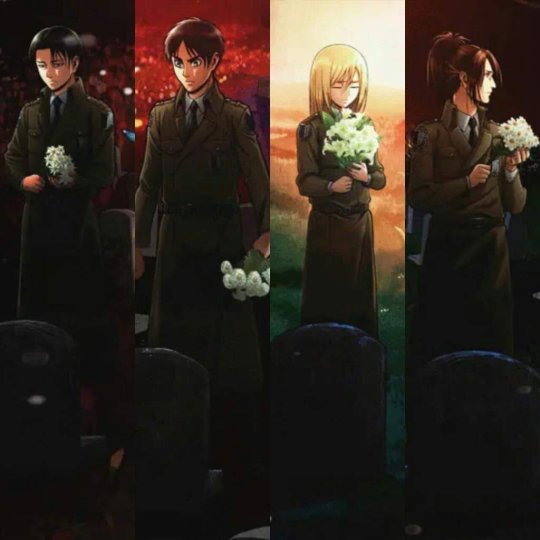
(Note: these are originally four different images, the source of this collage is vaguely anitwt).
Just as shown in the original PV by Linked Horizon, each of these characters are standing by a gravestone while holding a bouquet and looking conflicted. Now, to counter the original AnR theorists, I propose that Eren —and by extension, Historia— weren't the only ones to live on with regret in their hearts, instead, Levi and Hanji survived as well.
Why did they survive? Is my conclusion solely based on these pictures? Well, just in part.
I believe Attack on Titan was never meant to be a one-sided story, and that one of the various themes that weren't thoroughly explored in the later chapters, a theme which was instead rushed and swiftly overlooked, is that of the conflict between "Nationalism" and "Internationalism". It's obvious and needless to point out that Yaegerists were the former, but the latter never take a name for themselves. However, we get a rough idea of who they might be, one of them is clearly Hanji Zoe:
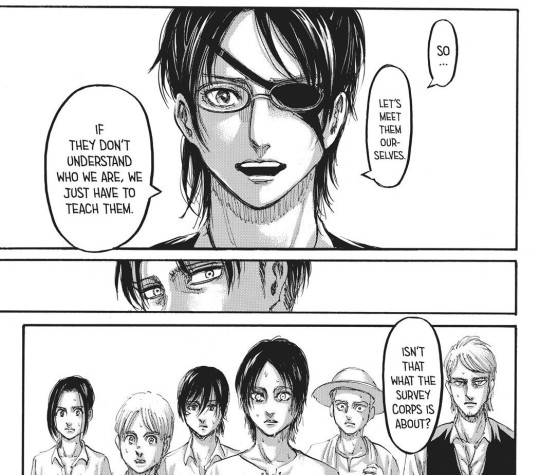
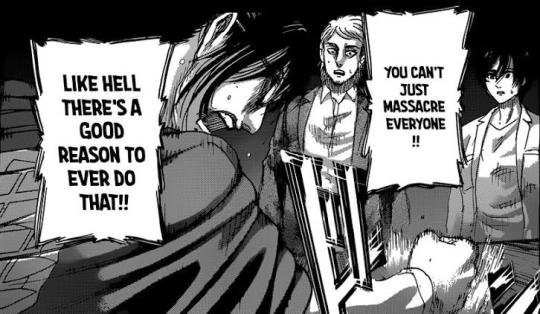
Another internationalist is obviously Onyankopon:
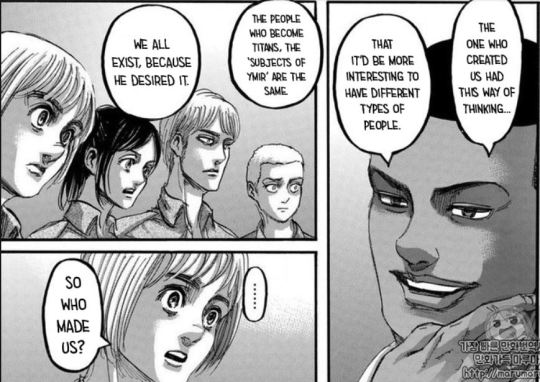
Another one is Armin and so on, and so on.
Are they the only type on people on Earth? Of course not. Notably you also have those who have egotistical motivations, like Jean, who just wants to get married and live a peaceful life in the inner cities; or the Hizuru ambassador, Kiyomi, whose motivation is monetary gain. The world isn't black and white in AoT so, to clarify, it's unnecessary to classify every character in the dichotomy here presented.
Now, if Yams hadn't downplayed this interaction, we may have had a better thought out plan to stop the Rumbling and, possibly, a less moronically cringy way for "The Alliance" to be presented.
Why is that? It's because of various reasons. First, one of the most observant characters, Hanji, is notable for having spied on some of Eren and Historia's interactions (the "You look happy — that's because I am" scene for example) but by the end of the story the audience never got a reason as to why this observant behavior happened. If Hanji really is as cunning and observant as she is portrayed to be, she should've been the first character to suspect that Eren is the father and, therefore, that Historia's pregnancy's due date was off. Instead of the survey corps discussing this info, we get some random officers discussing irrelevant rumours about it. Isayama I mean, Kawakubo played Hanji Zoe dirty, in my opinion, in this scenario.
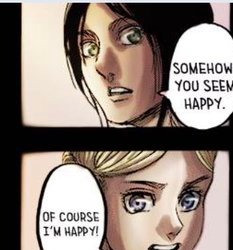
If Hanji had noticed that important information, and if that info had been shared with the Survey Corps, as was natural for her character to do, "the Alliance" may have had been able to act sooner against the AT.
Now, would more prep time save the world from devastation? No, I don't believe so. I believe it would, instead, make them have a slightly more realistic last fight by a) having them recruit actual soldiers and weapons for the final showdown, heck, if they have enough time even other countries would chime in, vs Hallu-chan and the Attach Titan; and, therefore, b) not having them rely on a Deus Ex Machina to defeat Eren.
That way, Hanji would live on with regret, knowing the Alliance did everything in their power to defeat the Attack Titan but failed miserably in the end. Instead of having her smile as her ghost-self at whatever the hell the canon battle achieved, she'd mourn the world that's been lost, and she'd feel regret for not being able to save it.
Now, for Levi I haven't done a thorough analysis yet, but I believe it's not difficult to see why humanity's strongest soldier would survive this ordain. I'd really like to hear someone else's thoughts on that matter.
Also, I'm in no way trying to imply LeviHan was supposed to be part of a kino ending, but I'm not too into that ship so I'd like to hear someone else's thoughts about it and on why they were the only two members of the alliance to survive according to WIT Studio's AnR official art.
Now, onto the second part of "who survived the Rumbling?". The next piece of information contradicts previous statements, and it also contradicts an AnR ending to some extent, but bare with me, please.
Exhibit A, Mikasa and Armin should have survived:

However, for Kruger's prophecy to succeed, I stand by my previous statement that "the Alliance" should've acted sooner, and that Armin is part of the Internationalist faction ready to "save humanity". Why do I believe that? It's easy, first, let's remember this quote from the moment Erwin died:
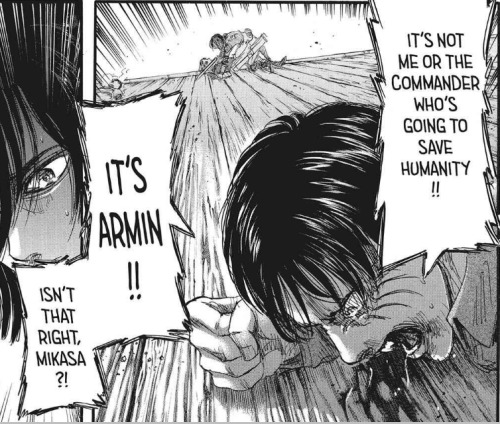
Note how, not only does Eren say Armin will save the humans, he also implies Mikasa will know it'll happen (so she'll be alive by the time the battle ends).
And, piggybacking on that moment as well, Armin would've been able to use his intellect to make a plan to divert the Rumbling titans. I'm adding this here to stress something that can't be stressed enough: Armin shouldn't have had to fistfight Eren twice, and he shouldn't have had to steal someone else's kill. Now onto that kill...
Should Mikasa have been the one to deal Eren's final blow? In the canon version of the story it's shown, in a rather cringy way, how she has to make up a whole different scenario inside her mind to get the mental strength to kill him. To me, Mikasa instead should've used the devastation caused by the Rumbling to completely break away from Eren's character and to be able to see past the "you're being brainwashed" narrative. Now, besides some of Isayama's interviews, there's other proof to back this up: the Historia-Mikasa parallels in Ending 4 and Ending 1:
Ending 1: https://youtu.be/O4wezNlsxB0
Ending 4: https://youtu.be/o05UK9lXtC0
We see some petty similarities in both: how both girls seem to be inside a pond or a lake, a snip of them running when they were young, etc.; but we also see some more important things for this theory: their growth as a person (how they survived whatever the past cast upon them), and them catching up to the people who they look up to and love.
Now, two things we know about Historia are that her beloved Ymir left her and she had to learn to accept it and move on; and that her sister, Frieda, died and she, without initially knowing even that she'd lost her, had to learn how to live on her own when she was young. Would Mikasa and Eren be able to have an end like that? I think it was implied that it was possible, but other than that, as part of any healthy development of her character, it is important for her to move on just as the Eldian Queen did: even if Eren chose to live a life apart from her (like Ymir did to Historia's early knowledge) or even if he were to die (like Frieda did).
Also, I have some doubts about Mikasa being the one who was supposed to kill Eren, since the one who was foreshadowed to be a Helos' parallel, and who'd fit the role just as well is Reiner, but I won't discuss that here.
So, to me, Mikasa was never an Internationalist, but for the sake of her character, a break-away from Eren should've been a good conclusive act.
As to some other parallels between Mikasa and Historia we have this part:
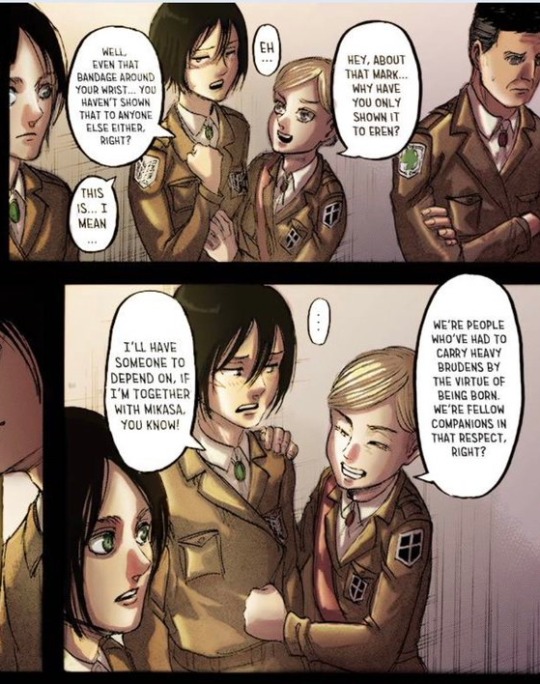
In which it is implied that they share the same burden by birth, and the same destiny, possibly. Mikasa is shown to be embarrassed about it but Historia seems to be thoroughly delighted.
With this parallel I'd also like to recall two other threads left undone: the Azumabito clan and the Ackerman mystery.
First, the Azumabitos. It's implied that their land is to "the Orient", and we also get a small snip during the Rumbling which implies they have a coast (it's obvious their country is a direct reference to Japan, needless to say). All of which would imply that, as it does in the Real World ™️, Hizuru is almost the Eastern-most Nation of AoT's world as well, and therefore, it may be one of the last countries that the Rumbling would have reached. If you add that they were the first people to send an ambassador to Paradis, you get: Hizuru being the first nation to be included in a possible Internationalist "Alliance" (had it been done in the appropriate time) against the Attack Titan; and you also get that this would increase their possibilities of surviving, at least just in part, the Rumbling.
Why is this important? Because AnR's lyrics do not imply the world will be completely and absolutely obliterated. AnR's lyrics imply the world will live on but the power dynamic of the world will be reversed: Paradis will rule, while the rest will be forced inside the cage.
https://www.musixmatch.com/lyrics/Linked-Horizon/Akatsuki-no-Requiem-TV-Size
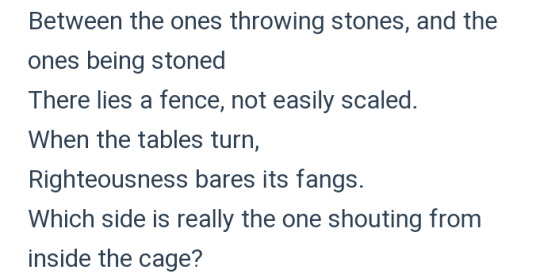
Now, the Ackermans. Just as Historia and Zeke posses a special particularity by virtue of birth (they are direct descendants of Ymir), which make them valuable assets to "breed" for whoever is using the Eldians (be it Marley, the Azumabitos, or the First King), I believe the outside world would be interested, at any part of the story, to have an Ackerman in their line of defense against the Eldians. In this case the Mikasa-Historia parallel is strengthened, simply because it would be interesting to see Levi or Mikasa confront that part of their destiny (to make the Ackerman clan continue for the sake of a plan, while acknowledging they're the only survivors). Perhaps Hizuru would've been the country to try and make use of that potential? This parallel was, of course, never used, but it would've been delightful to see it exploited at some point in the AoT timeline. However I acknowledge that continuity is impossible in a world without titans, unless one of the surviving countries on Earth are in serious need of Olympic competitors, of course, so perhaps it should've been mentioned before The Rumbling arc.
.
Well, this turned out to be more like a vent or a rant than a theory now, and I wish I could've had discussed it quietly with someone instead of just posting it here. There are some other nuances to this analysis that I would like to explore in the future (since this isn't thoroughly thought out) In the meantime what do you all think of a new AnR theory like this one? Does it make a little sense? At least a bit? I hope so. Thank you for reading and sorry about the grammar mistakes.
TLDR: I believe Armin, Mikasa, Eren, Historia, Hanji and Levi should have survived and also it's possible for Hizuru to have survived. Please feel free to point out any flaws.
#Eren#Attack on Titan#Armin#Mikasa#Levi#Hanji#AoT Theory#AnR Theory#just my personal thoughts#snk spoilers#aot spoilers#attack on titan spoilers#shingeki no kyojin spoilers#Historia Reiss#Ackerman clan#akatsuki no requiem#linked horizon#anr
56 notes
·
View notes
Note
Regarding Dio, even if I'm a pleb when it comes to Fantastic Four, I've come to consider him to be like a strange Shonen parallell to Doctor Doom, in that they both have borderline the flattest characterization and reason for set characterization possible but somehow OWNS that and their megalomania so spectacularily you can't help but enjoy it
Definitely not the first time I've seen the two compared to each other, but it's not unwarranted, they do have pretty striking similarities even besides being, well, world-conquering narcissistic and manipulative megalomaniacs, defined by their antagonism to their "brother" and his family, and a perpetual ambition for greater and greater depths of power, that inevitably fails to both sate their needs as well as prevent them from bringing their own downfall, defined to the bitter end by their unshakeable egos that both propel them to unmatched peaks of villainy as well as their own defeats.
Putting aside those few similarities, I wouldn't say it's that they have the flattest characterization, more so that, neither of the two characters is strongly centered around their respective "reasons" for being evil, in fact those tend to be downplayed or called into question even within their own narratives, and instead we get to learn more of them through their interactions with the world around them. They are these tour-de-force villains either puppeteering the story or steamrolling the narrative (almost literally in DIO's case) just by showing up, and mundane, nay, HUMAN nonsense such as "explanations" and "reasons for being evil" only really slow them down. They don't justify themselves to anyone, least of all the reader. Really, Doom would like nothing more than for his face to have been gruesomely destroyed in something less embarassing than a lab accident, and there's a reason we pretty much stop hearing the "Brando" part of Dio's name entirely past Part 1.
The two of them are even constructed similarly, in the sense that they are both depicted as characters who have a laundry list of virtues and admirable strengths, who do have a lot in common with the heroes and traits that the story recognizes as heroic, and who are even very much beloved by their creator and fans, but they have flaws that twist all of those into unrepentant monstrosity, which makes for a great contrast and allows them to be varying levels of both likeable and monstrous depending on the story's needs.
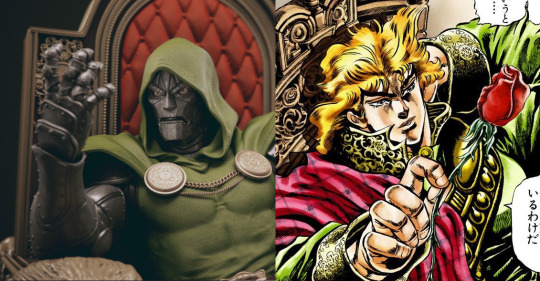
Dio and his art of killing. The art of being evil. Very cool, very awesome.
The title of the series is JoJo's Bizarre Adventure, but first and foremost, I actually wanted to draw Dio. How far can a man's ambition drive him when he takes it to the ultimate extreme? That's what I wanted to depict.
(On a section titled "The Protagonist Always Rises"): Dio also moves in a rising direction, like Jonathan. Dio accepts and embraces his evil nature and follows his dark path without hesitation. In other words, both Jonathan and Dio are living life with everything they've got, and both always maintain a rising personal arc. The violent clases between those rising forces of good and evil form the basis of the Jojo series.
When an evil character freely exhibits normally hidden desires and acts in a way the readers could not, the readers can find great catharsis. In the first story arc of JoJo, I always intended to make Dio look cool as he charged headlong down the villain's path, but I think it's due to that catharsis that some readers took to the character with incredible zeal - Taken from Araki's interviews, comments on JoJonium and his book "Manga In Theory and Practice"
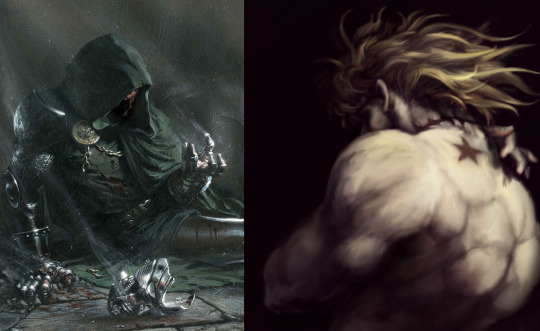
He’s not a bad guy, as you saw in the Fantastic Four. He’d give the Fantastic Four a wonderful meal… before he’d kill them. Doctor Doom isn’t all bad. He’s got a lot of class, he’s got a lot of culture. Doctor Doom is a college man, he’s a knowledgeable man. Doom is the kind of guy who’ll come over to your house for tea, shake your hand, be very friendly, and at the same time his henchmen are kidnapping your mother in the kitchen, while he chats with you in your living room.
Behind that steel mask, there’s a very handsome guy. But there’s one thing wrong with him. He’s got a scratch on his chin. And he’s frustrated; he knows he’s extremely handsome. He knows he’s got the scratch on his chin, but you haven’t.
Doom is an extremist, he’s paranoid. If Doom were to lose one hair, he’d put on a wig. And if Doom had an enemy, he’d have to wipe him out. And if Doom thought that anybody was smarter than himself, he’d kill ’em, because Doom would have to be the smartest man in the world. He’s an extremist; but, y’know, he has good manners.
What I did was a satire on a perfectionist. He felt that the tiny little scratch ruined the perfection of his face. That's the secret of Dr. Doom-he isn't ugly. He's handsome. But he's a perfectionist, and perfectionists are their own devils.
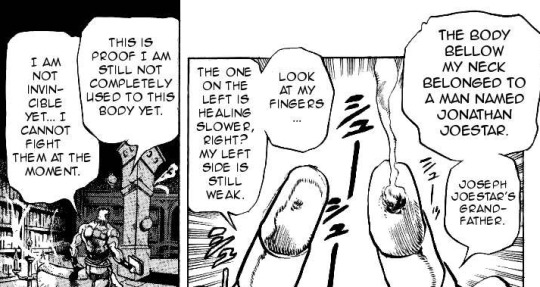
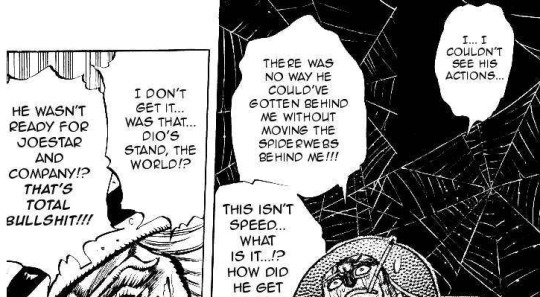
#replies tag#comic books tag#jojo tag#manga tag#dio#dio brando#doctor doom#dr doom#marvel comics#hirohiko araki#jack kirby#stardust crusaders
12 notes
·
View notes
Text
The King: Eternal Monarch (2020)
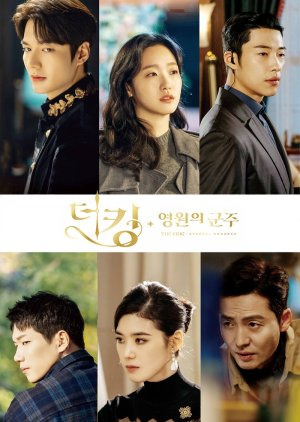
Summary
Yi Gon is the third Korean emperor of his generation. His citizens regard him as the perfect leader. But behind this flawless appearance, hides a deep wound. When he was eight years old, his father was murdered before his eyes following a coup. Today, instead of respecting his filial duty, he prefers to escape the palace to attend university conferences. During one of his escapades, he sees himself propelled into a parallel world where he meets Jeong Tae Eul, an inspector with whom he teams up with to defeat the criminals but also close the door between their two worlds.
Review
This review may contain spoilers
What Went Wrong in this Show ? - Not Worth Watching
Note : I'm hella sorry , if I hurt anyone your feeling by this review as if because I'm gonna be trashing the show . Completely a negative review . If y'all wanna positive review for this show , lemme down at comment section below ! When The King: Eternal Monarch was announced as the newest project of star writer Kim Eun-sook, drama fans were looking forward to another blockbuster hit. Kim probably has the longest-running streak of hit shows among Korean screenwriters. She has dominated three successive decades with award-winning and commercially successful shows, from her Lovers’ trilogy in the early 2000s, to Secret Garden and The Heirs in the 2010s, and finally, Descendants of the Sun, Goblin, and Mr. Sunshine in the 2020s. It seems that with The King: Eternal Monarch, Kim wanted to ring in the new decade with yet another hit but ended up not quite hitting the mark. The show premiered to much hype by virtue of being Lee Min-ho’s comeback drama and a decent 11% nationwide rating. Towards the second half, however, the show failed to move past the 6–8% bracket, ending its run with a measly 8% ratings. This was surprising, especially for a Kim Eun-sook drama, as her dramas are known for breaking ratings records. Many are wondering why, despite having so many factors to its advantage—a stellar lead pairing in Lee Min-ho and Kim Go-eun, interesting supporting cast featuring Woo Do-hwan, Lee Jung-jin, Jung Eun-chae, and Kim Kyung-nam, enormous budget, an exciting sci-fi premise, intense promotions by Netflix—did the show fail to make the splash we were all hoping for? Let’s look at some possible reasons. An Under-Utilized Villain The main villain of the show, Lee Rim, portrayed by the mysterious and dangerous-looking Lee Jung-jin, was probably one of the biggest let-downs in the plot. He is introduced to us as the evil uncle who leads a coup against Lee Gon’s father, steals the magical flute manpasikjeok, and tries to kill Lee Gon in the very first episode. Following this, he travels to a parallel world using the flute, finds his counterpart in that world, and kills him. Pretty scandalous, right? The show sets Lee Rim up to be a formidable villain, but the characterization all but falls apart in the later episodes. For the entire run of the show, viewers are not given a backstory for Lee Rim’s character. We know that he is evil but get no insight into either his motivations or what he’s actually scheming for. Is it political power? Does he want to rule both parallel worlds? Does he want to kill his nephew and take back the other half of the magical flute? We never find out. He stays a mystery throughout, and while that’s usually a desirable trait in a villain— this time, it fell woefully short of expectations. Lee Rim never feels dangerous or creepy enough for viewers to be invested in his eventual downfall, which, frankly, was just as disappointing as the character himself. Poor Choice of Leads One of the criticisms often leveled against Lee Min-ho is that he plays the same character in all his dramas. Here, too, he plays a role very similar to his previous dramas—the rich, bratty guy, except this time he’s an Emperor from a different world instead of a wealthy heir. The cocky rich guy is a concept even I, a non-fan of romance, tend to enjoy occasionally. But after Boys Over Flowers, The Heirs, City Hunter, Legend of the Blue Sea, and now The King: Eternal Monarch, it is getting boring and repetitive. Granted, no one does justice to this trope like Lee Min-ho does, but some range and depth in acting would be nice. That’s why I think King Lee Gon failed to charm viewers as easily as Lee Min-ho’s previous characters have. As for Kim Go-eun, having watched her films and her eventual transition to dramas, I personally think that she performs better in more serious, nuanced roles like the films Coin Locker Girl and Tune In For Love. She wasn’t bad in her debut drama Cheese in the Trap either, which was a slice-of-life show that didn’t require her to be in hyper-realistic settings. In Kim Eun-sook’s fantasy dramas,
however, Kim is prone to overacting—be it as Goblin‘s (Guardian: The Great and Lonely God) Ji Eun-tak or The King: Eternal Monarch’s Jung Tae-eul. Even within the show, she performed much better as the street smart Luna than the emotional Tae-eul. Minimalistic and nuanced acting seems to be much more within the actress’s range and depth. Lack of World Building A science-fiction romance fantasy involving time travel, multiple timelines, two parallel Koreas—one a monarchy and the other a democracy—the original concept of the show sounded too good to be true. And then it aired, and we realized that it really was too good to be true. Initial episodes set the stage for several mysteries—the power of the magic flute, the mechanics of traveling between two parallel worlds, everyone from one world having a doppelganger in the parallel world, Lee Rim’s schemes, and so on. But the developments of these arcs left a lot of be desired. For starters, the show doesn’t dedicate time to explaining the exact powers of the magical flute manpasikjeok, which is surprising because it is the most important piece of the puzzle in the show. The world building between the two Koreas starts off as promising but ends up getting confusing when viewers can’t tell which world the characters are supposed to be in. I wish there were color tones, or something I could have used to distinguish between the two words because I spent the first few episodes thoroughly lost. When the actual time-traveling begins, the plot is too far ahead for any tension to build up so viewers are left accepting whatever the show throws at them. Frankly, it came off as unrealistic that Lee Gon could travel back and forth in time, altering timelines, without any cosmic side-effects. Isn’t that the inherent rule and tragedy of every time-travel movie/show ever? No Build Up to the Romance For a romance drama by one of the greatest romance drama writers of all time, the romance in this show is shockingly lacking in depth. It begins quite abruptly with Lee Gon hugging a stunned Tae-eul at the end of the first episode itself. We only know that Lee Gon has grown up thinking Tae-eul saved his life. But what makes him fall in love with her, we never find out. Tae-eul, though initially distrustful of Gon, eventually opens up and falls for him, too, but this transition again is too jarring to tug at emotions and make the viewer invested in the relationship. The few kiss scenes we get lack any tension or buildup, seeming almost forced. As a viewer, it never felt like we saw Lee Gon and Tae-eul genuinely connect and as a result, their impending separation and reunion wasn’t as high stakes as it should have been. I was reminded of Kim Eun-sook’s previous dramas like Goblin (Guardian: The Great and Lonely God) and Descendants of the Sun, where the main couples’ banter and chemistry became one of the reasons for the shows’ success. Here, the dialogue was clichéd, romance was full of tired tropes, and chemistry was lacking. The happy ending didn’t end up being satisfying, and it hurts me to say it, because this story had so much potential. Excessive Product Placement (PPL) The excessive PPL in the show has also come under scanner, though this is a complaint mostly from Korean viewers. PPL is common in every drama with a big budget as broadcasters seek to recover the money they spent on the show. The difference between good and bad PPL, however, is that the former is cleverly injected into the plot and doesn’t ruin the flow, while the latter, well, does. Korean viewers have called this show’s PPL some of the most notorious they have ever seen in a drama, and let me tell you why. Almost every meal the characters are shown eating is the BBQ chicken they are promoting, and in one scene, Lee Min-ho’s character goes beyond eating to raving about the chicken…right in the middle of the plot! We know South Korea’s fried chicken is to die for, but come on. Several times, the show switches from a drama to an advertisement in the most jarring of transitions that break the flow of that particular
scene. Yet another instance is Kim Go-eun breaking character to promote a lip balm, while she is supposed to be on duty as a detective. Most international fans don’t even blink at the PPL in K-dramas, but this time, we did. Too Many Side Arcs Instead of building up the parallel worlds, the villains, and the lead couple’s story, the focus of the show seems to be on the many, many side characters as well as their counterparts in the parallel world. There are so many stories going on at once that focusing on one was difficult. Still, if the side arcs are done well, they only add to the plot. But side characters in The King: Eternal Monarch that looked like they would impact the main plot turned out to be irrelevant. I quite enjoyed Jo Yeong/Jo Eun-seob and Kang Shin-jae’s arcs, but Goo Seo-ryung, Prince Buyeong, Myeong Na-ri, and Min Hwa-yeon, who got significant screen time, eventually ended up contributing nothing. All this time could have been spent on developing Lee Rim’s character or the romance between Lee Gon and Tae-eul. All in all, The King: Eternal Monarch boasted of an amazing concept, but the execution left much to be desired. It seems that writer Kim Eun-sook tried to experiment with a new genre but got lost on the way. This is not to say that I’ve lost faith in her work—it’s simply a minor setback in a long and illustrious career. K-dramaland is bound to be just as excited for her next work as we were for this one. Have you watched The King: Eternal Monarch? Let us know your thoughts about the show in the comments below!
2 notes
·
View notes